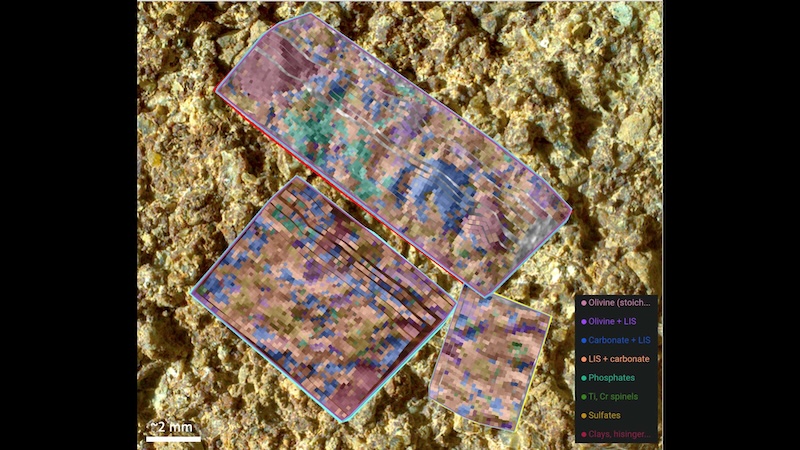NASA’s Perseverance rover has now passed 1,000 sols (Martian days) on Mars. And scientists have good reason to celebrate. The rover has been exploring an ancient delta, river and lake system in Jezero Crater, which could hold evidence of ancient microbial life. Perseverance has collected numerous samples for analysis both by the rover itself and in labs back on Earth. The samples provide an outline of the history of this water system from billions of years ago. NASA said on December 12, 2023, that they have revealed an environment that was not only habitable but would be ideal for preserving organic molecules from past life, if it existed there.
Mission scientists discussed the results so far on December 12 at the American Geophysical Union fall meeting (AGU23) in San Francisco. You can find abstracts for numerous related peer-reviewed papers on the AGU23 website.
The 2024 lunar calendars are here! Best New Year’s gifts in the universe! Check ’em out here.
Perseverance rover in Jezero Crater
Perseverance landed in Jezero Crater on February 18, 2021. Previous observations by orbiters showed that the crater was once a lake billions of years ago. There are also ancient river channels that once emptied into the lake, and a still well-preserved delta. This makes Jezero Crater an ideal location to search for evidence of ancient life, the rover’s primary mission. Ken Farley at Caltech in Pasadena, California, is the project scientist for the Perseverance mission. He said:
We picked Jezero Crater as a landing site because orbital imagery showed a delta; clear evidence that a large lake once filled the crater. A lake is a potentially habitable environment, and delta rocks are a great environment for entombing signs of ancient life as fossils in the geologic record. After thorough exploration, we’ve pieced together the crater’s geologic history, charting its lake and river phase from beginning to end.
Complex history of Jezero Crater
The Perseverance rover found volcanic igneous rock on the crater floor. Scientists say it formed from subsurface magma or other volcanic activity on the surface, or maybe both. That would be the original crater floor. But later, the rover also came across sedimentary sandstones and mudstones. Those formed when the river water first entered the crater. Then – on top of that – are salt-rich mudstones. These are left over from when the lake started evaporating. In addition, fast-flowing flood water brought in boulders from outside the crater and distributed them in the crater, including on top of the delta. Another paper presented at AGU23 discusses observations of these boulders by NASA’s Mars Reconnaissance Orbiter (MRO) spacecraft.
Through its history, mission scientists said the lake reached a maximum size of 22 miles (35 km) across and about 100 feet (30 meters) deep.


Intriguing samples
The samples contain an intriguing array of minerals that provide clues to Jezero Crater’s watery past and habitable conditions. One sample, obtained at the location Lefroy Bay, is abundant in fine-grained silica. This kind of silica is ideal for preserving organic molecules (including ones formed by biological processes) and even microscopic fossils. At Otis Peak, Perseverance found phosphate, some forms of which can play a key role in biochemistry. Phosphate is a component of DNA and is found in the cell membranes of all known life on Earth. In addition, it is part of a molecule that helps cells carry energy.
Perseverance also discovered carbonates in both samples. Carbonates can preserve evidence of the environmental conditions during which the rock formed. Carbonates form in watery environments and are good at preserving organic molecules.
The Perseverance rover also detected carbonates in the Bills Bay sample from another location. The Bills Bay rocks are rich in fine-grained silica, as well. Morgan Cable, the deputy principal investigator of the PIXL instrument on Perseverance at NASA’s Jet Propulsion Laboratory in Pasadena, California, said:
On Earth, this fine-grained silica is what you often find in a location that was once sandy. It’s the kind of environment where, on Earth, the remains of ancient life could be preserved and found later.
At yet another target location, Ouzel Falls, Perseverance identified iron associated with phosphate in the rocks.
An ancient wet and habitable environment
Altogether, these samples, plus earlier detections of a variety of organic compounds, paint a picture of a previously wet and habitable environment. Cable said:
We have ideal conditions for finding signs of ancient life where we find carbonates and phosphates, which point to a watery, habitable environment, as well as silica, which is great at preservation.
NASA’s Curiosity rover has also found abundant organic molecules in rocks in Gale Crater, which was also once a lake.
This video animation is an artist’s concept of when water first broke through the crater wall and into what is now called Jezero Crater billions of years ago. Video via NASA/ JPL-Caltech/ YouTube.
Perseverance rover and Mars Sample Return
Perserverance has collected 23 samples so far. They are being stored in small metal tubes about the size of a stick of chalk. They will, hopefully, be returned to Earth later for Mars Sample Return. The rover itself also has an onboard laboratory to analyze the samples, but any definitive conclusions as to possible evidence of life will likely have to wait until the samples can be studied in more advanced labs on Earth.
Bottom line: NASA’s Perseverance rover has collected 23 samples of rock so far in Jezero Crater on Mars. Analysis shows the ancient lake in the crater was quite habitable.
Sources: AGU23 (multiple paper abstracts)
Via NASA
Read more: Rover spies rock features on Mars with odd circular shapes
Read more: 10 months of Perseverance: New Mars discoveries